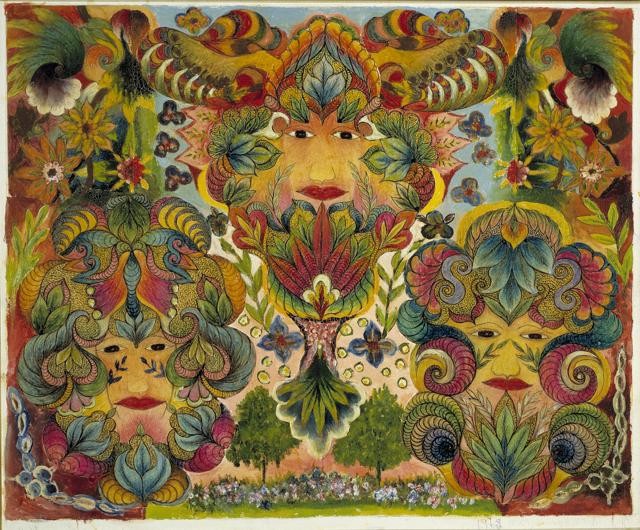The term outsider art is most commonly used to describe visionary, untrained and self-taught artists. More specifically, those artists deeply rooted in a regional vernacular and operating “outside” of the world of art museums, criticism and arts education.
So it may come as a surprise that an exhibition stocked with outsider works by the likes of Thornton Dial, Henry Darger and Minnie Evans — all categorically untrained and steeped in region — doesn’t address them as such. Instead, Social Geographies: Interpreting Space and Place, a new exhibition opening Sunday, Jan. 26, at the Asheville Art Museum, looks to connect these artists through their common representation of space and place in and throughout each work.
The paintings and three-dimensional assemblage of Dial and Lonnie Holley, both from Alabama, absorb and recreate the physical and ideological terrain of the deep South. In “Ground Level: By the Grace of God,” Dial has created a simulated bird’s-eye view of a rust-toned landscape. He’s built up rich textural layers reminiscent of his home with a combination of various metals, carpet, glue and enamel fastened onto a wood panel. Likewise, Holley explores his native state through elements of Southern black culture and historic figures, such as congressman John Lewis. Holley’s simultaneous inclusion of worn and battered everyday objects, such as shoes, echos a similar attention to the importance of historical roots.
But space and place aren’t limited to physical tangibility. In the narrow corridors of his Chicago apartment, Henry Darger composed illustrated story lines, one of which is more than 15,000 pages long. These are culled from a combination of imagined worlds and events, newspaper clippings and department store catalogs, among other visual stimuli.
Martín Ramírez’s drawings were rendered in the Northern Californian mental institution where he spent 32 years of his life after leaving Mexico in search of work. The inclusion of animals in his work reflects on his sense of isolation: The beasts diverge from the cellblock, taking refuge in winding linear abstractions evocative of movement and migration.
In the exhibition’s catalog essay, guest curator Dr. Leisa Rundquist, an associate professor of art history at UNC Asheville, notes that outsider art’s historical lineage draws from early comparisons to works made by Swiss psychiatric patients. That was in the mid-1940s. But those comparisons continued well into the ’70s, when the term outsider art was coined by art historian Roger Cardinal. (His use replaced French artist Jean Dubuffet’s precursory term, art brut, or raw art.) While Cardinal reasserted similar parallels to the clinically insane, he also broadened the term to include untrained artists, particularly with “extracultural” backgrounds, and those who had an artistic ignorance and naivety.
“Since then,” Rundquist says, “outsider art has remained historically and geographically contingent upon what a dominant culture perceives as dysfunctional or pathological.” The title often overlooks content and instead addresses the strangeness and peculiarities not of the work, but of the artist’s lifestyles and environs.
“There tends to be a correlation with disability — mental or physical — or something that helps to define a disfunction,” says Katie Johnson, a research assistant to the exhibition. “It’s a bit archaic,” she adds. It’s these barriers, which Rundquist and Johnson suggest are defunct, that Social Geographies is aiming to break down.
“The show grew out of conversations about how problematic the term ‘outsider’ is,” Rundquist says. “Outsider is a convenient label that presents these artists in a kind of freak-show way, but it’s placed upon the artists by another person.”
Social Geographies forgoes these formal classifications and draws focus to the notion of place. Both real and imagined, physical and psychological, place is relative. But either way, it’s experienced. And while these experiences-turned-memories are unique to the artists, Rundquist argues that the sensibility is inherent in all of the exhibit’s material.
In the works of Waynesville resident George Widener, space and place are recreated with numbers, dates and mathematical patterns. His pieces are documents of specific moments and extended periods of travel recorded meticulously in notebooks and chronologically reformatted into drawings.
Minnie Evans, a Wilmington-born artist, spent much of her life in southern coastal N.C., which manifests in her landscape and figure drawings. The pieces combine elements of traditional landscape scenery, native fauna and foliage and freeform faces abstracted by plant-like patterns. They’re memories, observations of her coastal environs. But they also represent greater spiritual facets of her life.
Place, unlike outsiderness (or, it could be argued, placelessness) is “a concept that’s loaded with personal connotations,” says Rundquist. “All these artists deal with place, and we see that as the connective tissue.”
what: Social Geography: Interpreting Space and Place
where: Asheville Art Museum, ashevilleart.org
when: Opens Sunday, Jan. 26, 2-5 p.m. Curator’s talk at 3 p.m.
The exhibit runs through May 18.






Before you comment
The comments section is here to provide a platform for civil dialogue on the issues we face together as a local community. Xpress is committed to offering this platform for all voices, but when the tone of the discussion gets nasty or strays off topic, we believe many people choose not to participate. Xpress editors are determined to moderate comments to ensure a constructive interchange is maintained. All comments judged not to be in keeping with the spirit of civil discourse will be removed and repeat violators will be banned. See here for our terms of service. Thank you for being part of this effort to promote respectful discussion.